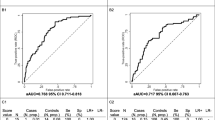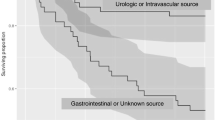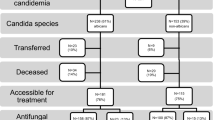Abstract
Purpose
Increasing prevalence of candidemia in Internal Medicine wards (IMWs) has been reported in recent years, but risk factors for candida bloodstream infection in patients admitted to IMW may differ from those known in other settings. The aim of this study was to identify risk factors and define a prediction rule for the early recognition of the risk of candidemia in IMW inpatients.
Methods
This was a multicentric, retrospective, observational case–control study on non-neutropenic patients with candidemia admitted to IMWs of four large Italian Hospitals. Each eligible patient with candidemia (case) was matched to a control with bacteremia. Stepwise logistic regression analyses were performed.
Results
Overall, 300 patients (150 cases and 150 controls) were enrolled. The following factors were associated with an increased risk of candidemia and weighted to build a score: total parenteral nutrition (OR 2.45, p = 0.008; 1 point); central venous catheter (OR 2.19, p = 0.031; 1 point); peripherally inserted central catheter (OR 5.63, p < 0.0001; 3 points), antibiotic treatment prior (OR 2.06; p = 0.059; 1 point) and during hospitalization (OR2.38, p = 0.033; 1 point); neurological disability (OR 2.25, p = 0.01; 1 point); and previous hospitalization within 3 months (OR 1.56, p = 0.163; 1 point). At ROC curve analysis, a final score ≥ 4 showed 84% sensitivity, 76% specificity, and 80% accuracy in predicting the risk of candidemia.
Conclusions
The proposed scoring system showed to be a simple and highly performing tool in distinguishing bloodstream infections due to Candida and bacteria in patients admitted to IMW. The proposed rule might help to reduce delay in empirical treatment and improve appropriateness in antifungal prescription in septic patients.
Similar content being viewed by others
References
Wisplinghoff H, Bischoff T, Tallent SM, Seifert H, Wenzel RP, Edmond MB. Nosocomial bloodstream infections in US hospitals: analysis of 24,179 cases from a prospective nationwide surveillance study. Clin Infect Dis. 2004;39:309–17.
Marchetti O, Bille J, Fluckiger U, et al. Epidemiology of candidaemia in Swiss tertiary care hospitals: secular trends, 1991–2000. Clin Infect Dis. 2004;38:311–20.
Morrell M, Fraser VJ, Kollef MH. Delaying the empiric treatment of Candida bloodstream infection until positive blood culture results are obtained: a potential risk factor for hospital mortality. Antimicrob Agents Chemother. 2005;49:3640–5.
Zimlichman E, Henderson D, Tamir O, et al. Health care-associated infections: a meta-analysis of costs and financial impact on the US health care system. JAMA Intern Med. 2013;173:2039–46.
Cleveland AA, Farley MM, Harrison LH, et al. Changes in incidence and antifungal drug resistance in candidemia: results from population-based laboratory surveillance in Atlanta and Baltimore, 2008–2011. Clin Infect Dis. 2012;55:1352–61.
Zaoutis TE, Argon J, Chu J, Berlin JA, Walsh TJ, Feudtner C. The epidemiology and attributable outcomes of candidemia in adults and children hospitalized in the United States: a propensity analysis. Clin Infect Dis. 2005;41:1232–9.
Wey SB, Mori M, Pfaller MA, Woolson RF, Wenzel RP. Hospital-acquired candidemia. The attributable mortality and excess length of stay. Arch Intern Med. 1988;148:2642–5.
Pfaller MA, Diekema DJ. Epidemiology of invasive candidiasis: a persistent public health problem. Clin Microbiol Rev. 2007;20:133–63.
Puig-Asensio M, Padilla B, Garnacho-Montero J, et al. Epidemiology and predictive factors for early and late mortality in Candida bloodstream infections: a population-based surveillance in Spain. Clin Microbiol Infect. 2014;20:O245–54.
Bassetti M, Merelli M, Righi E, et al. Epidemiology, species distribution, antifungal susceptibility, and outcome of Candidemia across five sites in Italy and Spain. J Clin Microbiol. 2013;51:4167–72.
Bassetti M, Taramasso L, Nicco E, Molinari MP, Mussap M, Viscoli C. Epidemiology. Species distribution, antifungal susceptibility and outcome of nosocomial Candidemia in a Tertiary Care Hospital in Italy. PLoS One. 2011;6:e24198.
Luzzati R, Merelli M, Ansaldi F, et al. Nosocomial candidemia in patients admitted to medicine wards compared to other wards: a multicentre study. Infection. 2016;44:747–55.
Ylipalosaari P, la-Kokko TI, Karhu J, et al. Comparison of the epidemiology, risk factors, outcome and degree of organ failures of patients with candidemia acquired before or during ICU treatment. Crit Care. 2012;16(2):R62.
Milazzo L, Peri AM, Mazzali C, et al. Candidaemia observed at university hospital in Milan (northern Italy) and review of published studies from 2010 to 2014. Mycopathologia. 2014;178:227–41.
De Rosa FG, Corcione S, Filippini C, et al. The effect on mortality of fluconazole or echinocandin treatment in candidemia in internal medicine wards. PLoS One. 2015;10:e0125149.
Hii IM, Chang HL, Lin LC, et al. Changing epidemiology of candidemia in a medical center in middle Taiwan. J Microbiol Immunol Infect. 2015;48:306–15.
Guimaraes T, Nucci M, Mendonca JS, et al. Epidemiology and predictors of a poor outcome in elderly patients with candidemia. Int J Infect Dis. 2012;16:e442–7.
Luzzati R, Cavinato S, Giangreco M, et al. Peripheral and total parenteral nutrition as the strongest risk factors for nosocomial candidemia in elderly patients: a matched case–control study. Mycoses. 2013;56:664–71.
León C, Ruiz-Santana S, Saavedra P, et al. A bedside scoring system (“Candida score”) for early antifungal treatment in nonneutropenic critically ill patients with Candida colonization. Crit Care Med. 2006;34:730–7.
Ostrosky-Zeichner L, Sabel C, Sobel J, et al. Multicenter retrospective development and validation of a clinical prediction rule for nosocomial invasive candidiasis in the intensive care setting. Eur J Clin Microbiol Infect Dis. 2007;26:271–6.
Paphitou NI, Ostrosky-Zeichner L, Rex JH. Rules for identifying patients at increased risk for candidal infections in the surgical intensive care unit: approach to developing practical criteria for systematic use in antifungal prophylaxis trials. Med Mycol. 2005;43:235–43.
Pittet D, Monod M, Suter PM, Frenk E, Auckenthaler R. Candida colonization and subsequent infections in critically ill surgical patients. Ann Surg. 1994;220:751–8.
Dunning J, Au JK, Millner RW, Levine AJ. Derivation and validation of a clinical scoring system to predict the need for an intra-aortic balloon pump in patients undergoing adult cardiac surgery. Interact Cardiovasc Thorac Surg. 2003;2:639–43.
Faiz S, Neale B, Rios E, et al. Risk-based fluconazole prophylaxis of Candida bloodstream infection in a medical intensive care unit. Eur J Clin Microbiol Infect Dis. 2009;28:689–92.
Dellinger RP, Levy MM, Rhodes A, et al. Surviving sepsis campaign: international guidelines for management of severe sepsis and septic shock. Intensive Care Med. 2013;39:165–228.
Imtiaz R, Hawken S, McCormick BB, Leung S, Hiremath S, Zimmerman DL. Diabetes mellitus and younger age are risk factors for hyperphosphatemia in peritoneal dialysis patients. Nutrients. 2017;9:2.
Hon HH, Wojda TR, Barry N, et al. Injury and fatality risks in aeromedical transport: focus on prevention. J Surg Res. 2016;204:297–303.
Piombo AC, Gagliardi JA, Guetta J, et al. A new scoring system to stratify risk in unstable angina. BMC Cardiovasc Disord. 2003;3:8.
Soto A, Solari L, Agapito J, et al. Development of a clinical scoring system for the diagnosis of smear-negative pulmonary tuberculosis. Braz J Infect Dis. 2008;12:128–32.
Falagas ME, Aostolou KE, Pappas VD. Attributable mortality of candidemia. Eur J Clin Microbiol Infect Dis. 2006;25:419–25.
Peres-Bota D, Rodriguez-Villalobos H, Dimopoulos G, Melot C, Vincent JL. Potential risk factors for infection with Candida spp. in critically ill patients. Clin Microbiol Infect. 2004;10:550–5.
Wenzel RP. Nosocomial candidemia: risk factors and attributable mortality. Clin Infect Dis. 1995;20:1531–4.
Tascini C, Sozio E, Tintori G, et al. Peripherally inserted central catheter as a predominant risk factor for candidemia in critically ill patients in internal medicine wards in Italy. Intensive Care Med. 2015;41:1498–9.
Luzzati R, Cavinato S, Deiana ML, Rosin C, Maurel C, Borelli M. Epidemiology and outcome of nosocomial candidemia in elderly patients admitted prevalently in medical wards. Aging Clin Exp Res. 2015;27:131–7.
Laupland KB, Gregson DB, Church DL, Ross T, Elsayed S. Invasive Candida species infections: a 5 year population-based assessment. J Antimicrob Chemother. 2005;56:532–7.
Barchiesi F, Orsetti E, Mazzanti S, et al. Candidemia in the elderly: what does it change? PLOS ONE. 2017;12:e0176576.
Falcone M, Concia E, Iori I, et al. Identification and management of invasive mycoses in internal medicine: a road-map for physicians. Intern Emerg Med. 2014;9:501–11.
Tortorano AM, Prigitano A, Lazzarini C, et al. A 1-year prospective survey of candidemia in Italy and changing epidemiology over one decade. Infection. 2013;41:655–62.
McClave SA, Martindale RG, Rice TW, Heyland DK. Feeding the critically ill patient. Crit Care Med. 2014;42:2600–10.
Shin JH, Kee SJ, Shin MG, et al. Biofilm production by isolates of Candida species recovered from nonneutropenic patients: comparison of bloodstream isolates with isolates from other sources. J Clin Microbiol. 2002;40:1244–8.
Branchini ML, Pfaller MA, Rhine-Chalberg J, Frempong T, Isenberg HD. Genotypic variation and slime production among blood and catheter isolates of Candida parapsilosis. J Clin Microbiol. 1994;32:452–6.
Swindell K, Lattif AA, Chandra J, Mukherjee PK, Ghannoum MA. Parenteral lipid emulsion induces germination of Candida albicans and increases biofilm formation on medical catheter surfaces. J Infect Dis. 2009;200:473–80.
Pappo I, Polacheck I, Zmora O, Feigin E, Freund HR. Altered gut barrier function to Candida during parenteral nutrition. Nutrition. 1994;10:151–4.
Falcone M, Tiseo G, Tascini C, et al. Assessment of risk factors for candidemia in non-neutropenic patients hospitalized in internal medical wards: a multicentre study. Eur J Int Med. 2017;41:33–8.
Tascini C, Falcone M, Bassetti M, et al. Candidemia in patient with body temperature below 37 °C and admitted to internal medicine wards: assessment of risk factors. Am J Med. 2016;129:1330.e1–6.
Pieralli F, Corbo L, Torrigiani A, et al. Usefulness of procalcitonin in differentiating Candida and bacterial blood stream infections in critically ill septic patients outside the intensive care unit. Intern Emerg Med. 2017;12:629–35.
Funding
No financial support was received.
Author information
Authors and Affiliations
Consortia
Corresponding author
Ethics declarations
Conflict of interest
CT has received funds for speaking at symposia organized on behalf of Pfizer, Novartis, Merck, and Astellas. All other authors: none to declare.
Electronic supplementary material
Below is the link to the electronic supplementary material.
Rights and permissions
About this article
Cite this article
Sozio, E., Pieralli, F., Azzini, A.M. et al. A prediction rule for early recognition of patients with candidemia in Internal Medicine: results from an Italian, multicentric, case–control study. Infection 46, 625–633 (2018). https://doi.org/10.1007/s15010-018-1162-0
Received:
Accepted:
Published:
Issue Date:
DOI: https://doi.org/10.1007/s15010-018-1162-0




